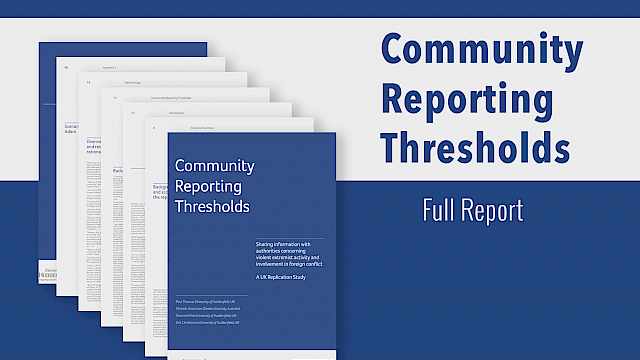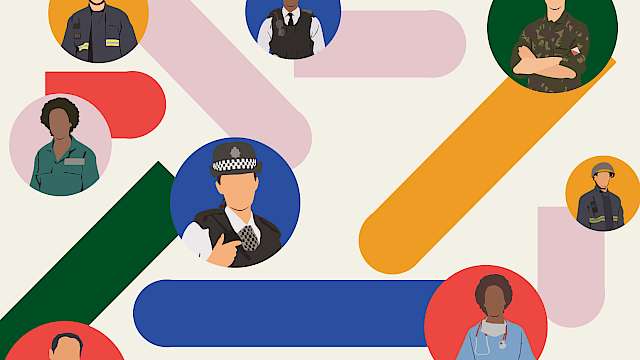Existing research does not indicate that there is a direct causal link between neurodivergence and engagement in criminality or violent extremism in the general population. However, while estimates vary, a proportion of individuals within violent extremist populations are also neurodivergent. Within these individuals, specific symptoms of neurodivergent conditions such as autism spectrum disorder (ASD) and attention-deficit/hyperactivity disorder (ADHD) may contextualise vulnerability to such engagement, as well as resilience and disengagement, that may differ from their neurotypical counterparts.
This systematic review therefore aimed to investigate:
- The functional role of ASD and ADHD in the context of vulnerability and/or resilience to radicalisation, terrorism, and mass violence.
- Risk management of individuals in these contexts.
- Recommendations for professional training, skill, and effectiveness in these contexts.
- The quality, extent, and gaps of the existing research in this field.
We identified 58 publications from a variety of different fields and publication sources. The findings were synthesised using a qualitative thematic analysis of the included documents. Nine key themes emerged from the review:
- Prevalence of ASD/ADHD in extremist/mass murderer populations.
- Social and Relationship Difficulties which may lead to isolation, grievances, and engagement with extreme ideologies and actors online.
- Hyperfixation, Obsessionality, and Circumscribed Interests including interests in mass murder, weapons, and extreme ideologies.
- Cognitive Styles including rigid thinking; a need for predictability, rules, and routines; impulsivity; and associated difficulties at work or school.
- Sensory Issues including difficulties associated with over-sensitivity, under-sensitivity, and sensation-seeking behaviours.
- Vivid Fantasies and Ideation which may include violent ideation or narratives of grandiosity.
- Emotional Dysregulation contributing to frustration, anxiety, and grievance.
- Complex Needs, Comorbidities, and Trauma which may interact with or exacerbate difficulties and grievances.
- Enhancing Resilience and Considerations for Practice including integrating these considerations into threat/risk assessment and management.
The review indicated that in neurodivergent individuals within at-risk populations, a multitude of different factors can contribute to violent extremism and mass violence risk – often involving the presence and combination of different diagnoses, traits, environmental factors, and stressors that uniquely combine in individuals. Within populations of concern, risk assessment approaches may benefit from considering how neurodivergent traits and symptoms can contextualise risk, vulnerability, and resilience; and their interaction with external and convergent factors. Considering the push and pull factors to mass violence and violent extremism through the lens of neurodivergence may also be relevant for supporting disengagement.
The Full Report of this Systematic Review is coming soon. In the meantime, you can download the Executive Summary and Overview on this page.
Read more
Al-Attar, Z. (2018a). Development and Evaluation of Guidance to Aid Risk Assessments of Offenders with Autism. Unpublished MA Dissertation, Sheffield Hallam University.
Al-Attar, Z. (2018b). Interviewing Terrorism Suspects and Offenders with an Autism Spectrum Disorder. The International Journal of Forensic Mental Health, 17(4), 321–337. https://doi.org/10.1080/14999013.2018.1519614
Al-Attar, Z. (2019a). Extremism, radicalisation & mental health: Handbook for practitioners. Radicalisation Awareness Network: Health & Social Care Subgroup, European Commission. https://home-affairs.ec.europa.eu/pages/page/ran-hsc-handbook-extremism-radicalisation-mental-health-handbook-practitioners-november-2019_en
Al-Attar, Z. (2020). Autism spectrum disorders and terrorism: How different features of autism can contextualise vulnerability and resilience. Journal of Forensic Psychiatry and Psychology, 31(6), 926–949. https://doi.org/10.1080/14789949.2020.1812695
Al-Attar, Z. (2021). Framework for the Assessment of Risk & Protection in Offenders with Attention Deficit Hyperactivity Disorder (FARAH). Unpublished Manual.
Al-Attar, Z. (2019b). Introducing the FARAS – a Framework to Aid Risk Assessment with Offenders on the Autistic Spectrum. 18th International Conference on Offenders with an Intellectual and/or Developmental Disability, Birmingham, April 11.
Al-Attar, Z., & Abbasian, C. (2021). ADHD in Adult Prisons: Opportunities for Responsive Rehabilitation, Effective Treatment & Thriving. Unpublished Manuscript.
Allely, C. S. (2018). A systematic PRISMA review of individuals with autism spectrum disorder in secure psychiatric care: Prevalence, treatment, risk assessment and other clinical considerations. Journal of Criminal Psychology, 8(1), 58–79. https://doi.org/10.1108/JCP-06-2017-0028
Allely, C. S. (2020). The contributory role of psychopathology and inhibitory control in the case of mass shooter James Holmes. Aggression and Violent Behavior, 51. https://doi.org/10.1016/j.avb.2020.101382
Allely, C. S., & Faccini, L. (2017a). A Conceptual Analysis of Individuals with an Autism Spectrum Disorder Engaging in Mass Violence. Journal of Forensic and Crime Studies, 1(1), 1–5. https://doi.org/10.18875/2638-3578.1.105
Allely, C. S., & Faccini, L. (2017b). ‘Path to intended violence’ model to understand mass violence in the case of Elliot Rodger. Aggression and Violent Behavior, 37, 201–209. https://doi.org/10.1016/j.avb.2017.09.005
Allely, C. S., & Faccini, L. (2019). Clinical profile, risk, and critical factors and the application of the “path toward intended violence” model in the case of mass shooter Dylann Roof. Deviant Behavior, 40(6), 672–689. https://doi.org/10.1080/01639625.2018.1437653
Allely, C. S., Minnis, H., Thompson, L., Wilson, P., & Gillberg, C. (2014). Neurodevelopmental and psychosocial risk factors in serial killers and mass murderers. Aggression and Violent Behavior, 19(3), 288–301. https://doi.org/10.1016/j.avb.2014.04.004
Allely, C. S., Wilson, P., Minnis, H., Thompson, L., Yaksic, E., & Gillberg, C. (2017). Violence is rare in autism: When it does occur, is it sometimes extreme? The Journal of Psychology: Interdisciplinary and Applied, 151(1), 49–68. https://doi.org/10.1080/00223980.2016.1175998
Anaele, B. (2020). Risk Factors Related to School Shootings [Master’s thesis, Wilfrid Laurier University]. Wilfrid Laurier University Theses and Dissertations (Comprehensive). https://scholars.wlu.ca/etd/2287/
Bhui, K. (2018). Radicalisation and mental health. Nordic Journal of Psychiatry, 72(sup1), S16–S19. https://doi.org/10.1080/08039488.2018.1525640
Bhui, K., Otis, M., Silva, M. J., Halvorsrud, K., Freestone, M., & Jones, E. (2020). Extremism and common mental illness: Cross-sectional community survey of White British and Pakistani men and women living in England. The British Journal of Psychiatry, 217(4), 547–554. https://doi.org/10.1192/bjp.2019.14
Bjørkly, S. (2009). Risk and dynamics of violence in Asperger’s syndrome: A systematic review of the literature. Aggression and Violent Behavior, 14(5), 306–312. https://doi.org/10.1016/j.avb.2009.04.003
Blum, K., Chen, A. L.-C., Braverman, E. R., Comings, D. E., Chen, T. J., Arcuri, V., Blum, S. H., Downs, B. W., Waite, R. L., Notaro, A., Lubar, J., Williams, L., Prihoda, T. J., Palomo, T., & Oscar-Berman, M. (2008). Attention-deficit-hyperactivity disorder and reward deficiency syndrome. Neuropsychiatric Disease and Treatment, 4(5), 893–918. https://doi.org/10.2147/ndt.s2627
Bramer, W. M., Giustini, D., De Jong, G. B., Holland, L., & Bekhuis, T. (2016). De-duplication of database search results for systematic reviews in EndNote. Journal of the Medical Library Association, 104(3), 240–243. https://doi.org/10.3163/1536-5050.104.3.014
Bronner, S. J. (2014). ‘The Shooter Has Asperger’s’: Autism, Belief, and ‘Wild Child’ Narratives". Children’s Folklore Review, 36, 35–53.
Broyd, J., Boniface, L., Parsons, D., Murphy, D., & Hafferty, J. D. (2022). Incels, violence and mental disorder: A narrative review with recommendations for best practice in risk assessment and clinical intervention. BJPsych Advances, 1–11. https://doi.org/10.1192/bja.2022.15
Campelo, N., Oppetit, A., Neau, F., Cohen, D., & Bronsard, G. (2018). Who are the European youths willing to engage in radicalisation? A multidisciplinary review of their psychological and social profiles. European Psychiatry, 52, 1–14. https://doi.org/10.1016/j.eurpsy.2018.03.001
Clemmow, C., Gill, P., Bouhana, N., Silver, J., & Horgan, J. (2022). Disaggregating Lone-actor Grievance-fuelled Violence: Comparing Lone-actor Terrorists and Mass Murderers. Terrorism and Political Violence, 34(3), 558–584. https://doi.org/10.1080/09546553.2020.1718661
Clemmow, C., Schumann, S., Salman, N. L., & Gill, P. (2020). The Base Rate Study: Developing Base Rates for Risk Factors and Indicators for Engagement in Violent Extremism. Journal of Forensic Sciences, 65(3), 865–881. https://doi.org/10.1111/1556-4029.14282
Corner, E., & Gill, P. (2014). A False Dichotomy? Mental Illness and Lone-Actor Terrorism. Law and Human Behavior, 39(1), 23–34. https://doi.org/10.1037/lhb0000102
Corner, E., Gill, P., & Mason, O. (2016). Mental Health Disorders and the Terrorist: A Research Note Probing Selection Effects and Disorder Prevalence. Studies in Conflict and Terrorism, 39(6), 560–568. https://doi.org/10.1080/1057610X.2015.1120099
Corner, E., Taylor, H., Van Der Vegt, I., Salman, N., Rottweiler, B., Hetzel, F., Clemmow, C., Schulten, N., & Gill, P. (2021). Reviewing the links between violent extremism and personality, personality disorders, and psychopathy. The Journal of Forensic Psychiatry & Psychology, 1–30. https://doi.org/10.1080/14789949.2021.1884736
Del Pozzo, J., Roche, M. W., & Silverstein, S. M. (2018). Violent behavior in autism spectrum disorders: Who’s at risk? Aggression and Violent Behavior, 39, 53–60. https://doi.org/10.1016/j.avb.2018.01.007
Eagan, S. H., VosWinkel, F., Ford, J. D., Lyddy, C., Schwartz, H. I., & Spencer, A. (2014). Shooting at Sandy Hook Elementary School. State of Connecticut Office of the Child Advocate. https://portal.ct.gov/-/media/OCA/SandyHook11212014pdf.pdf
Erlandsson, Å., & Meloy, J. R. (2018). The Swedish School Attack in Trollhättan. Journal of Forensic Sciences, 63(6), 1917–1927. https://doi.org/10.1111/1556-4029.13800
Faccini, L. (2010). The man who howled wolf: Diagnostic and treatment considerations for a person with ASD and impersonal repetitive fire, bomb and presidential threats. American Journal of Forensic Psychiatry, 31(4), 47–68.
Faccini, L. (2016). The Application of the Models of Autism, Psychopathology and Deficient Eriksonian Development and the Path of Intended Violence to Understand the Newtown Shooting. Archives of Forensic Psychology, 1(3), 113.
Faccini, L., & Allely, C. S. (2016). Mass violence in individuals with Autism Spectrum Disorder and Narcissistic Personality Disorder: A case analysis of Anders Breivik using the “Path to Intended and Terroristic Violence” model. Aggression and Violent Behavior, 31, 229–236. https://doi.org/10.1016/j.avb.2016.10.002
Faccini, L., & Allely, C. S. (2017a). Path towards an Impromptu Shooting in an Individual with Autism Spectrum Disorder. International Journal of Psychology Research, 12(3), 183–195.
Faccini, L., & Allely, C. S. (2017b). Rare instances of individuals with autism supporting or engaging in terrorism. Journal of Intellectual Disabilities and Offending Behaviour, 8(2), 70–82. https://doi.org/10.1108/JIDOB-11-2016-0022
Fitzgerald, M. (2015). Autism and School Shootings—Overlap of Autism (Asperger’s Syndrome) and General Psychopathy. In M. Fitzgerald (Ed.), Autism Spectrum Disorder—Recent Advances (pp. 3–12). InTech. https://doi.org/10.5772/58882
Fox, J. M., Brook, M., Stratton, J., & Hanlon, R. E. (2016). Neuropsychological profiles and descriptive classifications of mass murderers. Aggression and Violent Behavior, 30, 94–104. https://doi.org/10.1016/j.avb.2016.06.014
Gill, P., Clemmow, C., Hetzel, F., Rottweiler, B., Salman, N., Van Der Vegt, I., Marchment, Z., Schumann, S., Zolghadriha, S., Schulten, N., Taylor, H., & Corner, E. (2021). Systematic Review of Mental Health Problems and Violent Extremism. Journal of Forensic Psychiatry and Psychology, 32(1), 51–78. https://doi.org/10.1080/14789949.2020.1820067
Gill, P., & Corner, E. (2017). There and back again: The study of mental disorder and terrorist involvement. American Psychologist, 72(3), 231–241. https://doi.org/10.1037/amp0000090
Hanlon, R. E., Rubin, L. H., Jensen, M., & Daoust, S. (2010). Neuropsychological features of indigent murder defendants and death row inmates in relation to homicidal aspects of their crimes. Archives of Clinical Neuropsychology, 25(1), 1–13. https://doi.org/10.1093/arclin/acp099
Higham, L., Girardi, A., & Edwards, H. V. (2021). Clinical and criminal profile of internet offenders with ASD. Journal of Intellectual Disabilities and Offending Behaviour, 12(2), 61–74. https://doi.org/10.1108/JIDOB-09-2020-0016
HM Inspectorate of Prisons, HM Inspectorate of Probation, & HM Inspectorate of Constabulary and Fire & Rescue Services. (2021). Neurodiversity in the criminal justice system: A review of evidence. https://www.justiceinspectorates.gov.uk/hmicfrs/publications/neurodiversity-in-the-criminal-justice-system/
Hoffman, B., Ware, J., & Shapiro, E. (2020). Assessing the Threat of Incel Violence. Studies in Conflict and Terrorism, 43(7), 565–587. https://doi.org/10.1080/1057610X.2020.1751459
Inderberg, A. M. S., Horndalsveen, K., Elvehaug, A. H., Mehmi, Y., Jørstad, I., & Bakken, T. L. (2019). Autism, intellectual disabilities and additional psychosis, and affiliation to groups with violent ideology: Short communication. Journal of Intellectual Disabilities and Offending Behaviour, 10(1), 1–7. https://doi.org/10.1108/JIDOB-09-2018-0010
Johnson, R. (2015). Towards an Evidence-Based Clinical Forensic Diagnostic Assessment Framework for Juvenile Fire Setting and Bomb Making: DSM-5 Quadrant. Journal of Forensic Psychology Practice, 15(3), 275–293. https://doi.org/10.1080/15228932.2015.1022479
King, C., & Murphy, G. H. (2014). A systematic review of people with autism spectrum disorder and the criminal justice system. Journal of Autism and Developmental Disorders, 44(11), 2717–2733. https://doi.org/10.1007/s10803-014-2046-5
Knecht, C., de Alvaro, R., Martinez-Raga, J., & Balanza-Martinez, V. (2015). Attention-deficit hyperactivity disorder (ADHD), substance use disorders, and criminality: A difficult problem with complex solutions. International Journal of Adolescent Medicine and Health, 27(2), 163–175. https://doi.org/10.1515/ijamh-2015-5007
Krasenberg, J., & Wouterse, L. (2019). Understanding the mental health disorders pathway leading to violent extremism. Radicalisation Awareness Network, European Commission. https://home-affairs.ec.europa.eu/pages/page/ran-hsc-understanding-mental-health-disorders-pathway-leading-violent-extremism-turin-13-march-2019_en
Leary, M. R., Kowalski, R. M., Smith, L., & Phillips, S. (2003). Teasing, Rejection, and Violence: Case Studies of the School Shootings. Aggressive Behavior, 29(3), 202–214. https://doi.org/10.1002/ab.10061
Lindberg, N., Sailas, E., & Kaltiala-Heino, R. (2012). The copycat phenomenon after two Finnish school shootings: An adolescent psychiatric perspective. BMC Psychiatry, 12(91), 1–11. https://doi.org/10.1186/1471-244X-12-91
Little, R., Ford, P., & Girardi, A. (2021). Online self-radicalisation: A case study of cognitive vulnerabilities for radicalization to extremism and single actor terrorism. Journal of Intellectual Disabilities and Offending Behaviour, 12(3–4), 112–123. https://doi.org/10.1108/JIDOB-03-2021-0006
Lloyd, M. (2021). Ethical Guidelines for Working on P/CVE in Mental Health Care. Radicalisation Awareness Network, European Commission. https://home-affairs.ec.europa.eu/networks/radicalisation-awareness-network-ran/publications/ethical-guidelines-working-pcve-mental-health-care-2021_en
Lloyd, M., & Dean, C. (2015). The development of structured guidelines for assessing risk in extremist offenders. Journal of Threat Assessment and Management, 2(1), 40–52. https://doi.org/10.1037/tam0000035
Logan, C., & Lloyd, M. (2018). Violent extremism: A comparison of approaches to assessing and managing risk. Legal and Criminological Psychology, 1–21. https://doi.org/10.1111/lcrp.12140
Lösel, F., King, S., Bender, D., & Jugl, I. (2018). Protective Factors Against Extremism and Violent Radicalization: A Systematic Review of Research. International Journal of Developmental Sciences, 12(1–2), 89–102. https://doi.org/10.3233/DEV-170241
McLaughlin, T., Blum, K., Steinberg, B., Siwicki, D., Campione, J., Badgaiyan, R. D., Braverman, E. R., Modestino, E. J., Gondre-Lewis, M. C., Baron, D., Mash, D. C., Giordano, J., & Thanos, P. K. (2017). Hypothesizing Las Vegas and Sutherland Springs Mass Shooters Suffer from Reward Deficiency Syndrome: ‘Born Bad’. Journal of Reward Deficiency Syndrome and Addiction Science, 3(2), 28–31. https://doi.org/10.17756/jrdsas.2017-038
Meeks, S. (2020). The Neural Implantation: Cognitive Difference and Contemporary Culture: Vol. Doctor of [Doctoral thesis, Manchester Metropolitan University]. Manchester Metropolitan University’s Research Repository. https://e-space.mmu.ac.uk/626969/
Meloy, J. R., & Pollard, J. W. (2017). Lone‐Actor Terrorism and Impulsivity. Journal of Forensic Sciences, 62(6), 1643–1646. https://doi.org/10.1111/1556-4029.13500
Metzl, J. M., & MacLeish, K. T. (2015). Mental Illness, mass shootings, and the politics of American firearms. American Journal of Public Health, 105(2), 240–249. https://doi.org/10.2105/AJPH.2014.302242
Misiak, B., Samochowiec, J., Bhui, K., Schouler-Ocak, M., Demunter, H., Kuey, L., Raballo, A., Gorwood, P., Frydecka, D., & Dom, G. (2019). A systematic review on the relationship between mental health, radicalization and mass violence. European Psychiatry, 56, 51–59. https://doi.org/10.1016/j.eurpsy.2018.11.005
Moczynski, N. P., Schiller, A. R., Farah, T. N., & Drogin, E. Y. (2022). The Role of Psychometrics in Investigating Lone-Actor Terrorism. In J. C. Holzer, A. J. Dew, P. R. Recupero, & P. Gill (Eds.), Lone-Actor Terrorism (pp. 85–95). Oxford University Press. https://doi.org/10.1093/med/9780190929794.003.0007
Moher, D., Shamseer, L., Clarke, M., Ghersi, D., Liberati, A., Petticrew, M., Shekelle, P., Stewart, L. A., Estarli, M., Barrera, E. S. A., Martínez-Rodríguez, R., Baladia, E., Agüero, S. D., Camacho, S., Buhring, K., Herrero-López, A., Gil-González, D. M., Altman, D. G., Booth, A., … Whitlock, E. (2015). Preferred reporting items for systematic review and meta-analysis protocols (PRISMA-P) 2015 statement. Systematic Reviews, 4(1). https://doi.org/10.1186/2046-4053-4-1
Monahan, J. (2012). The individual risk assessment of terrorism. Psychology, Public Policy, and Law, 18(2), 167–205. https://doi.org/10.1037/a0025792
Murphy, D. (2022). Risk assessment with autistic people. In Working with Autistic People in the Criminal Justice and Forensic Mental Health Systems (pp. 105–116). Routledge. https://doi.org/10.4324/9781003036722-11
Murray, A., Koronczai, B., Király, O., Griffiths, M. D., Mannion, A., Leader, G., & Demetrovics, Z. (2022). Autism, Problematic Internet Use and Gaming Disorder: A Systematic Review. Review Journal of Autism and Developmental Disorders, 9(1), 120–140. https://doi.org/10.1007/s40489-021-00243-0
National Autistic Society. (2023). What is autism. https://www.autism.org.uk/advice-and-guidance/what-is-autism
Nylander, L., Holmqvist, M., Gustafson, L., & Gillberg, C. (2013). Attention-deficit/hyperactivity disorder (ADHD) and autism spectrum disorder (ASD) in adult psychiatry. A 20-year register study. Nordic Journal of Psychiatry, 67(5), 344–350. https://doi.org/10.3109/08039488.2012.748824
O’Nions, E., Petersen, I., Buckman, J. E. J., Charlton, R., Cooper, C., Corbett, A., Happé, F., Manthorpe, J., Richards, M., Saunders, R., Zanker, C., Mandy, W., & Stott, J. (2023). Autism in England: Assessing underdiagnosis in a population-based cohort study of prospectively collected primary care data. The Lancet Regional Health - Europe, 29, 100626. https://doi.org/10.1016/j.lanepe.2023.100626
Ouzzani, M., Hammady, H., Fedorowicz, Z., & Elmagarmid, A. (2016). Rayyan—A web and mobile app for systematic reviews. Systematic Reviews, 5(1), 210. https://doi.org/10.1186/s13643-016-0384-4
Page, M. J., McKenzie, J. E., Bossuyt, P. M., Boutron, I., Hoffmann, T. C., Mulrow, C. D., Shamseer, L., Tetzlaff, J. M., Akl, E. A., Brennan, S. E., Chou, R., Glanville, J., Grimshaw, J. M., Hróbjartsson, A., Lalu, M. M., Li, T., Loder, E. W., Mayo-Wilson, E., McDonald, S., … Moher, D. (2021). The PRISMA 2020 statement: An updated guideline for reporting systematic reviews. BMJ, 372(71). https://doi.org/10.1136/bmj.n71
Palermo, M. T. (2013). Developmental disorders and political extremism: A case study of Asperger syndrome and the neo-Nazi subculture. Journal of Forensic Psychology Practice, 13(4), 341–354. https://doi.org/10.1080/15228932.2013.817890
Peter, E., Seidenbecher, S., Bogerts, B., Dobrowolny, H., & Schone, M. (2019). Mass murders in Germany—Classification of surviving offenders based on the examination of court files. Journal of Forensic Psychiatry & Psychology, 30(3), 381–400. https://doi.org/10.1080/14789949.2019.1593486
Pressman, D. E., Duits, N., Rinne, T., & Flockton, J. (2018). VERA-2R Violent Extremism Risk Assessment-Version 2 Revised. Netherlands Ministry of Security and Justice, Netherlands Institute for Forensic Psychiatry and Psychology.
Rice, T. R., & Hoffman, L. (2015). Adolescent mass shootings: Developmental considerations in light of the Sandy Hook shooting. International Journal of Adolescent Medicine and Health, 27(2), 183–187. https://doi.org/10.1515/ijamh-2015-5009
Rolling, J., & Corduan, G. (2018). Radicalization, a new adolescent symptom? Neuropsychiatrie de l’enfance et de l’adolescence, 66(5), 277–285. https://doi.org/10.1016/j.neurenf.2017.10.002
Schuurman, B. (2020). Research on Terrorism, 2007–2016: A Review of Data, Methods, and Authorship. Terrorism and Political Violence, 32(5), 1011–1026. https://doi.org/10.1080/09546553.2018.1439023
Shawcross, W. (2023). Independent Review of Prevent. https://www.gov.uk/government/publications/independent-review-of-prevents-report-and-government-response
Shine, J., & Cooper-Evans, S. (2016). Developing an autism specific framework for forensic case formulation. Journal of Intellectual Disabilities and Offending Behaviour, 7(3), 127–139. https://doi.org/10.1108/JIDOB-04-2015-0006
Silva, J. A., Ferrari, M. M., & Leong, G. B. (2003). Asperger’s disorder and the origins of the Unabomber. American Journal of Forensic Psychiatry, 24(2), 5–44.
Skelhorn, E., Girardi, A., & Cooper-Evans, S. (2023). A feasibility study to identify the presence of autism specific risk factors in secure services using an autism specific framework. Journal of Intellectual Disabilities and Offending Behaviour, ahead-of-print(ahead-of-print). https://doi.org/10.1108/JIDOB-03-2023-0003
Sturmey, P. (2019). Treatment outcomes for people with autistic spectrum disorder in forensic settings. In W. R. Lindsay, L. A. Craig, & D. Griffiths (Eds.), The Wiley handbook on what works for offenders with intellectual and developmental disabilities: An evidence-based approach to theory, assessment, and treatment. (pp. 373–387). John Wiley & Sons Ltd. https://doi.org/10.1002/9781119316268.ch20
Trimbur, M., Amad, A., Horn, M., Thomas, P., & Fovet, T. (2021). Are radicalization and terrorism associated with psychiatric disorders? A systematic review. Journal of Psychiatric Research, 141, 214–222. https://doi.org/10.1016/j.jpsychires.2021.07.002
Van Brunt, B., & Taylor, C. (2020). Understanding and Treating Incels: Case Studies, Guidance, and Treatment of Violence Risk in the Involuntary Celibate Community. Routledge. https://doi.org/10.4324/9780367824396
Wachtel, L. E., & Shorter, E. (2013). Autism plus psychosis: A ‘one-two punch’ risk for tragic violence? Medical Hypotheses, 81(3), 404–409. https://doi.org/10.1016/j.mehy.2013.05.032
Walter, F., Leonard, S., Miah, S., & Shaw, J. (2020). Characteristics of autism spectrum disorder and susceptibility to radicalisation among young people: A qualitative study. Journal of Forensic Psychiatry and Psychology, 32(3), 408–429. https://doi.org/10.1080/14789949.2020.1854831
Weenink, A. W. (2015). Behavioral Problems and Disorders among Radicals in Police Files. Perspectives on Terrorism, 9(2), 17–33.
Weisbrot, D. M. (2008). Prelude to a school shooting? Assessing threatening behaviors in childhood and adolescence. Journal of the American Academy of Child and Adolescent Psychiatry, 47(8), 847–852. https://doi.org/10.1097/CHI.0b013e3181799fd3
White, S. G. (2017). Case study: The Isla Vista campus community mass murder. Journal of Threat Assessment and Management, 4(1), 20–47. https://doi.org/10.1037/tam0000078
White, S. G., Meloy, J. R., Mohandie, K., & Kienlen, K. (2017). Autism spectrum disorder and violence: Threat assessment issues. Journal of Threat Assessment and Management, 4(3), 144–163. https://doi.org/10.1037/tam0000089
Woodbury-Smith, M. R., Loftin, R., Westphal, A., & Volkmar, F. R. (2022). Vulnerability to Ideologically-Motivated Violence Among Individuals With Autism Spectrum Disorder. Frontiers in Psychiatry, 13, 1–6. https://doi.org/10.3389/fpsyt.2022.873121
World Health Organisation. (2019a). 6A02 Autism spectrum disorder. In International statistical classification of diseases and related health problems (ICD) (11th ed.). http://id.who.int/icd/entity/437815624
World Health Organisation. (2019b). 6A05 Attention deficit hyperactivity disorder. In International statistical classification of diseases and related health problems (ICD) (11th ed.). http://id.who.int/icd/entity/821852937
Copyright Information
As part of CREST’s commitment to open access research, this text is available under a Creative Commons BY-NC-SA 4.0 licence. Please refer to our Copyright page for full details.
IMAGE CREDITS: Copyright ©2024 R. Stevens / CREST (CC BY-SA 4.0)






